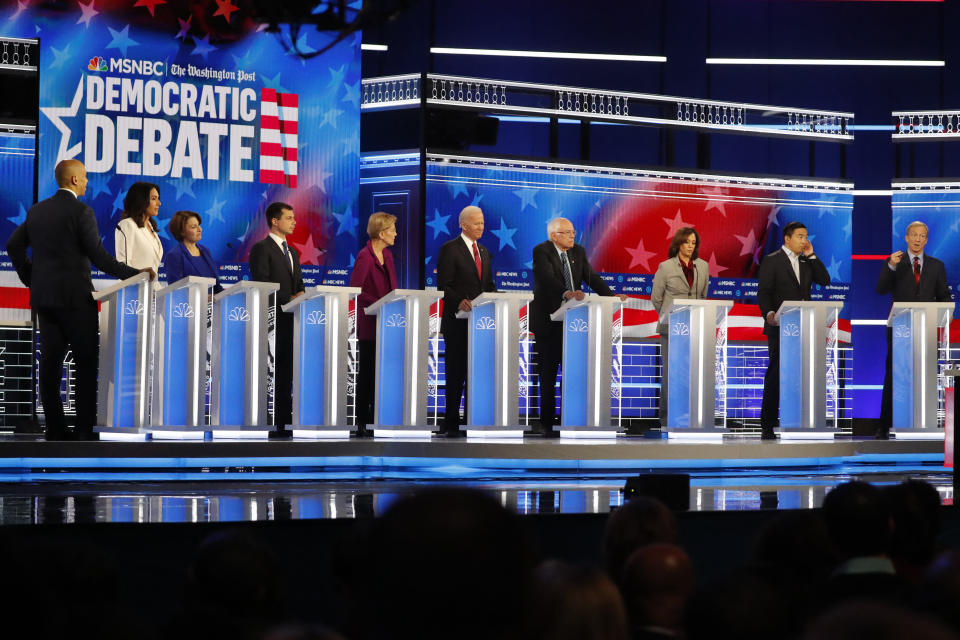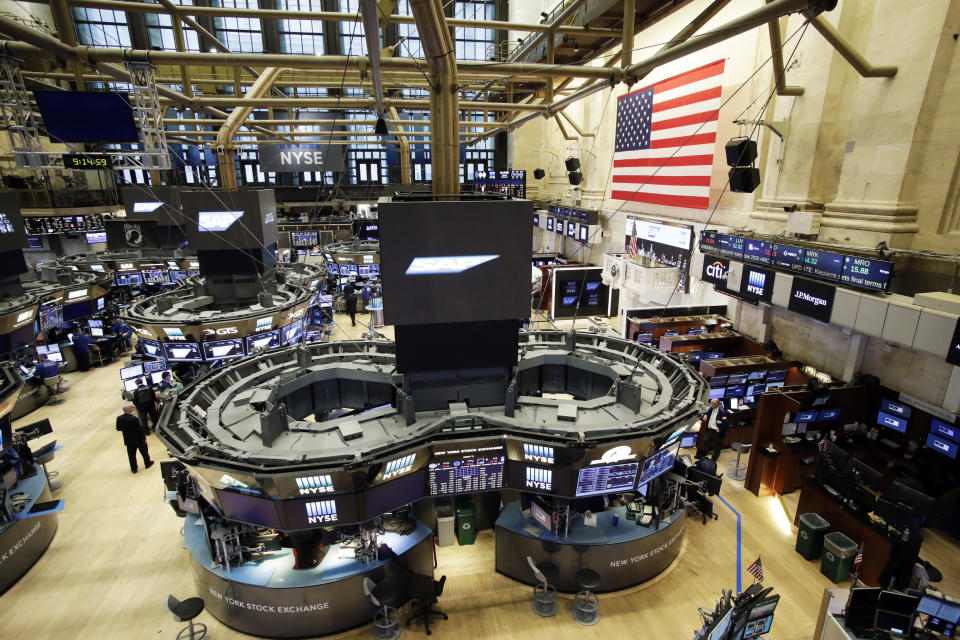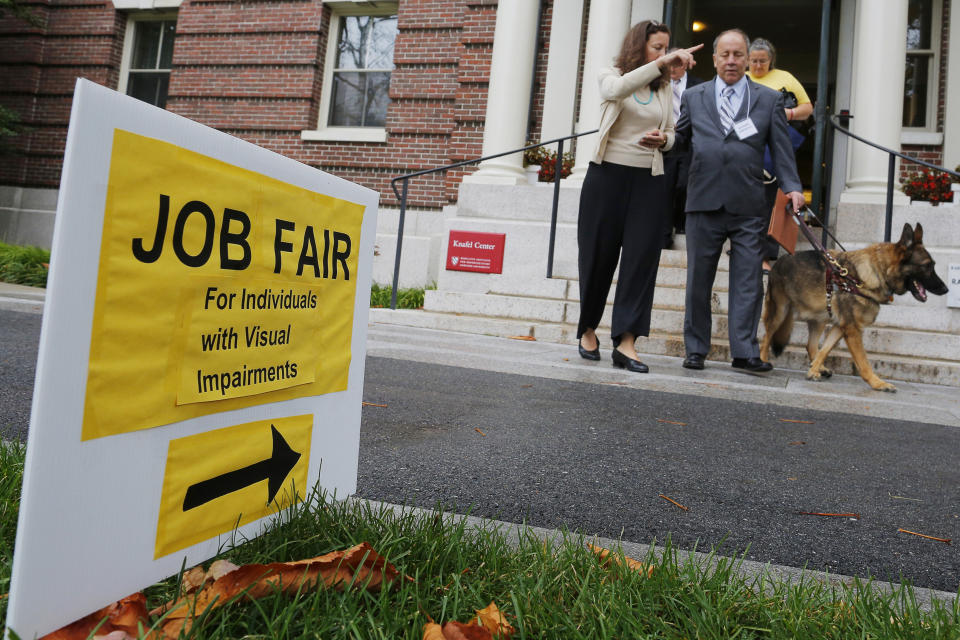Stock Market Live Updates: Stocks end higher after U.S.-China trade deal reached in principle
Follow Yahoo Finance here for up-to-the-minute briefings on the financial markets, breaking news and other topics of interest to investors and traders. Please check back for continuing coverage.
4:04 p.m ET: Stocks end higher after U.S.-China trade deal reached in principle
Here’s where the markets settled at the end of regular equity trading Thursday:
S&P 500 (^GSPC): +0.85%, or 26.89 points
Dow (^DJI): +0.79%, or 220.42 points
Nasdaq (^IXIC): +0.73%, or 63.27 points
10-year Treasury yield (^TNX): +10.4 bps to 1.894%
Gold (GC=F): -0.11% to $1,473.40 per ounce
3:04 p.m. ET: Boeing falls 2% after delaying plans to up 737 jet production
Shares of Boeing (BA) fell 1.9% after a Bloomberg report that the company has delayed its plans to reach a production rate of 57 of its 737 jets per month. Boeing now plans to hit its target in April 2021 according to the report.
2:34 p.m. ET: Phase-one U.S.-China deal reached in principle
U.S. and China negotiators reached terms for a phase-one trade deal between the two countries, Bloomberg reports, leaving the next step President Donald Trump’s approval. Trump and trade advisors are set to meet at 2:30 p.m. ET to discuss the agreement and an announcement could come this afternoon.
1:52 p.m. ET: Tech, health sectors boosted by trade optimism
Shares of Microsoft (MSFT) and Apple (APPL) hit record highs in the wake of trade optimism Wednesday, according to a Yahoo Finance analysis. The tech sector in general got a boost, with the Technology Select Sector SPDR Fund (XLK) hitting a record high.
Several other S&P 500 sector ETFs also hit record highs, including the Financial Select Sector SPDR Fund (XLF), the Communication Services Select Sector SPDR Fund (XLC), the Consumer Staples Select Sector SPDR Fund (XLP), and the Health Care Select Sector SPDR Fund (XLV).
1:35 p.m. ET S&P: ‘Weakest links’ debt risk highest since 2009

The binge of corporate bond issuance in an environment of historically low rates is a growing concern of a slowing economy. On Thursday, S&P Global Ratings underscored those concerns with new data showing that the debt market’s “weakest links”— or issuers with “junk” rated debt with negative outlooks — rose to 272 last month, up from 266 in October.
According to Sudeep Kesh, head of S&P Global Credit Markets Research, that’s nothing to sneeze at:
"Historically, this is the highest tally since September 2009--and significant, because weakest links typically default at a rate eight times that of standard-bearer speculative-grade issuers.”
S&P also noted that the media and leisure sector has the most additions with four issuers, though the consumer products sector leads the tally with 49 weakest links (18% of the total).
Recently, bond billionaire Jeff Gundlach told Yahoo Finance’s Julia LaRoche that the next credit crisis will be more severe — and it will be in corporate credit, where companies are holding record levels of debt on their books. He called the corporate bond market "probably significantly overrated, which sounds a lot like subprime in 2006."
12:00 p.m. ET: S&P sets record after Trump promises ‘BIG’ trade deal
The president’s promise of a ‘BIG’ trade deal was enough to send the S&P 500 Index to a new intraday high, and stocks remain broadly bid. Also helping is a Wall Street Journal report which said U.S. negotiators are promising a cut in tariffs as part of a mini-agreement:
U.S. negotiators have offered to slash existing tariffs by as much as half on roughly $360 billion of Chinese-made goods as well as to cancel a new round of levies set to take effect Sunday, according to people briefed on the matter, as the two sides work toward a limited trade deal that could help prevent their shaky relationship from worsening.
11:35 a.m. ET: The costs of the trade war: $42 billion
As the U.S. and China continue negotiations over a trade deal, the damage continues across many areas of the country. Since the trade war commenced in February 2018, Americans have paid an additional $42 billion, according to a new analysis from Tariffs Hurt the Heartland (THH).
Yahoo Finance’s Adriana Belmonte, who’s been covering this subject for months, has the full story.
11:15 a.m. ET: How key is 2020 to the market? Watch S&P 500, DB says

In an era of high polarization — featuring indexes that correlate Trump tweets to market volatility and analysts crunching the impact of a potential Elizabeth Warren win on the market — investors are more worried about politics than they’ve arguably ever been.
Well, Deutsche Bank’s Alan Ruskin takes it a step further with this analysis:
No doubt there is plenty of scope for spurious correlation with these two nonstationary series, but the rise in the Democratic centrists candidates in the polls as measured by the Predictit expectations on who the Democratic candidate will be, has been strongly correlated with the October turn and subsequent strength in the S&P.
The sum, of the implied probability of the centrist candidates has been tracking between 60% and 70% from near 40% in late September. While there are many other factors at play - think evidence from PMIs of the global economy bottoming; US labor market resilience; and, some waxing & waning optimism on US-China trade – it is likely that the increased probability of a centrist Democratic candidate has contributed to ‘the bleed up’ in the S&P, by reducing perceived downside tail risks.
In other words, the waxing of Democratic moderates like former VP Joe Biden and South Bend Mayor Pete Buttigieg — at the expense of Warren and Sanders — is encouraging markets to believe the impact of their policies, if elected, would be minimal.
All of this is speculative at best, especially because swing state data suggests Trump is weathering the storm of potential impeachment. Still, with investors clearly focused on politics, Ruskin’s analysis is worthy of at least some merit. He added the following:
The Democratic candidate expectations have by far the strongest correlations with the S&P, and a much weaker linkage versus FX variables, like the USD or FX carry measures, that are subject to a wider variety of international drivers. Note, that there is some argument that a centrist Democrat candidate would not only be better for the USD than a candidate from the Democratic left, but would also be more constructive for the USD, than a second term for President Trump.
A second Trump term would include potentially disruptive appointments at the Fed, most notably the Chair and Vice-Chair appointments that come up in early 2022. Historically, the USD has done best under a Democrat President subject to GOP Congressional constraints
10:40 a.m. ET: The $50 trillion (with a “T” market)

There’s been some debate about the growing role of exchange-traded funds in the marketplace, and whether they add to market volatility. Well, get ready to fasten your seatbelts, because Bank of America expects ETFs to grow in size and scope:
We estimate ETF asset growth of 25% driving year-end 2020 assets of $5.3 trillion and the current growth rate points to ETF assets approaching $50 trillion over the next decade, driven by a continued move to passive and increased awareness of the attractive tax efficiency, cost, liquidity and transparency characteristics of ETFs.
In 2020, Fixed Income ETF flows will continue to punch above their weight, fee pressures are likely to remain, Thematic ETFs could see strong growth and non-transparent active ETFs remain a show-me story.
Regarding the volatility question, BofA noted that “ETF stock ownership has limited impact on market liquidity,” adding that “historically, there has been only a small difference between the average bid/ask spread for S&P 500 stocks that are the most held and least held by ETFs.
The bank added that “the fundamental mechanics of the ETF structure combined with the functions of market participants across the broader ETF ecosystem suggest that there is more to the ETF impact on overall equity market liquidity than meets the eye.”
10:22 a.m. ET: Chinese company defaults on dollar bonds in ugly milestone
The latest sign of how a weakening Chinese economy is affecting the Middle Kingdom’s debt-heavy economy, which is becoming increasingly acute amid the trade war.
A major Chinese commodities trader became the biggest dollar bond defaulter among the nation’s state-owned companies in two decades, in a moment of reckoning for Beijing as it struggles to contain credit risk in a weakening economy.
Tewoo Group Corp. announced results of its unprecedented debt restructuring, which saw a majority of its investors accepting heavy losses. This is expected to reshape investors’ perceptions about government-owned borrowers whose identity has for years offered a relatively strong sense of security.
10:00 a.m. ET: Does the surge in jobless claims matter?

The sturdy U.S. labor market has been the most pleasant surprise of a slowing economy. but Thursday’s jobless claims — which spiked unexpectedly by 49,000 to 252K in the latest week — momentarily gave some market watchers pause.
JPMorgan Chase economist Daniel Silver had this to say:
...This was a larger increase than we had forecasted and even more of a disappointment relative to consensus expectations. We think that the recent volatility in the claims data is likely due to seasonal adjustment issues that we often see around the holiday season, and we saw a similar pattern across the weekly claims readings around Thanksgiving in 2013 (when the holiday fell on November 28 like it did this year). And the underlying trend in the labor market probably has not changed as much as implied on the surface by the jump in claims from one of the most favorable readings in recent years during the week ending November 30 to one of the most downbeat readings in a couple of years during the week ending December 7.
Conditions in the labor market are very likely not as downbeat as a literal reading of the latest weekly claims figure implies, but it does look like the trend in claims filings has moved up somewhat relative to what was reported a few months ago. If the weekly claims data continue to behave similarly to what happened during this time of year in 2013, we likely will see another elevated level of claims filings before some improvement later on in the year, although it is unlikely that the upcoming weekly changes in claims will precisely match what occurred in 2013.

So is the resilient job market showing signs of wear? It’s far too early to tell, especially since we’re only a week removed from a blowout figure in November’s nonfarm payrolls data.
That said, Bloomberg’s daily newsletter had a noteworthy take on labor conditions (courtesy of a question from Yahoo Finance):
The most interesting thing that Fed Chairman Jay Powell said at his press conference yesterday came in response to the final question of the day when he was asked by Brian Cheung of Yahoo Finance what it would take for Powell to characterize the labor market as "hot." Powell replied that it all came down to wages, and that while he was comfortable saying the labor market was strong, he wasn't comfortable calling it either tight or hot because wage growth still isn't that fast.
What struck me about this answer is that for years now, people have been using words like "hot" or "tight" to describe the labor market and virtually nobody bats an eye. It's just taken as accepted that with the unemployment rate down at 3.5%, and employers complaining about the difficulty of finding workers, that it might be tight. And yet here's the Fed chair refusing to either one of these terms. And for good reason: a truly hot labor market would see faster pay.
...If people stop blithely using words like "hot" and "normal" to describe the economy or interest rates, and actually look at what the data is saying, it may filter into better policy decisions.
9:40 a.m. ET: Trump says ‘very close’ to US-China trade deal
In a tweet, President Donald Trump says a Sino-American ‘Phase One’ deal is “very close”:
Getting VERY close to a BIG DEAL with China. They want it, and so do we!
— Donald J. Trump (@realDonaldTrump) December 12, 2019
Healthy skepticism is required, as traders have heard this one several times before (one Wall Street wag once likened Trump’s trade talk to “Peanuts” character Lucy goading Charlie Brown into kicking the football, only to snatch it away at the last second).
That said, markets are eager for news with a December 15 deadline looming, which will see a new round of tariffs imposed if it lapses. Stocks turn higher on the day on the president’s remark.
9:30 a.m. ET: Stocks flat to weaker after Fed: All eyes on trade talks
U.S. stocks opened Thursday on a flat note, with traders uninspired by the Federal Reserve’s decision to hold the line on interest rates at current levels, which most economists think won’t budge for the foreseeable future.
Here’s where markets began trading Thursday:
S&P 500 (^GSPC): +0.11%, or 3.5 points
Dow (^DJI): +0.05%, or 14.63 points
Nasdaq (^IXIC): +0.14%, or 12.50 points
10-year Treasury yield (^TNX): flat to 1.81%
Gold (GC=F): +0.93% to $1,488.70 per ounce
Powell and Company signaled they were on hold indefinitely, and Barclays on Thursday highlighted that the median FOMC member doesn’t see rate movement before 2021. That said, DataTrek’s Nicholas Colas points out the following:
The Fed’s last meeting of 2019 showed a united front, with policymakers at historically all-time high levels of conviction that the central bank will leave rates unchanged in 2020. Markets disagree, with Fed Funds Futures showing a +50% chance of further cuts in 2020. That assessment isn’t just macroeconomic bearishness; Powell’s own comments had a distinctly dovish tilt.
Follow Yahoo Finance on Twitter, Facebook, Instagram, Flipboard, LinkedIn, and reddit.
Find live stock market quotes and the latest business and finance news

 Yahoo Finance
Yahoo Finance 